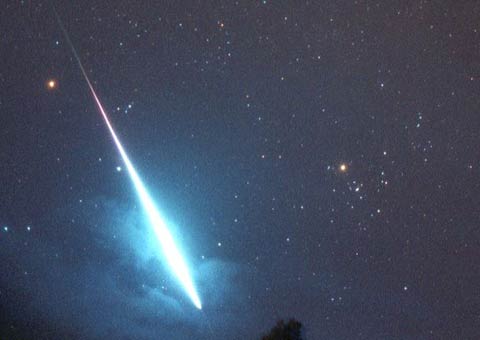A celestial object explodes in the Earth's atmosphere
Last week an astronomical object exploded in the sky of Africa and did not harm the Earth, exactly as astronomers predicted for the first time.

The object is about the size of a dining table, as astronomers predicted; and they also guessed that the meteor left nothing after the explosion, apart from a few small pieces falling on the surface of the globe.
No photographs of the explosion were taken due to the distance from the object's path to Sudan. But the explosion is recorded by a low-noise receiver (sound has a frequency below the level of human hearing) located in Kenya. Based on the negative data, Peter Brown of the University of Western Ontario estimated that the object exploded at 0243 UT (international coordinated time) with an energy level of 1,100-2,100 tons of TNT.
Earlier, NASA observers some other scientists announced that the meteorite - named 8TA9D69 - will enter the atmosphere at 10:46 pm on October 7 (0246 international time) in northern Sudan. Although there are similar events that happen a few times a year, they have never been predicted exactly like this time. It is expected that the object will create a brilliant fireball that the naked eye can see, and even more beautiful than other meteor cases when the debris of the celestial body passes through the Earth's atmosphere.
"A normal meteor is born from an object the size of a grain of sand," explains Gareth Williams of the Small Planet Research Center just before the event. "This meteor will truly be the most beautiful star!"
Only one case confirmed that this meteor was expected. According to Spaceweather.com, Jacob Kuiper, an aviation meteorologist at the Dutch National Weather Center, told pilots to watch carefully.
"I was asserted by a pilot of the Royal Dutch airline (KLM) at about 750 nautical miles southeast of the position predicted to collide, and observed the fire in time. Shortly before the estimated time of the explosion - 0246 UTC, Kuiper said. "Because it is too far away, it is not clear to observe this interesting phenomenon, but still insists that a bright meteor has been seen at the project site. guess".
The meteorite discovered by a study is being carried out at Mount Lemmon - operated by the University of Arizona - part of a NASA-funded program called Catalina Sky Survey (funded by NASA) to search for objects near Earth.
- Announcing shocking information about celestial star temperature
- Discover the largest celestial object cluster in the universe
- Overview of Uranus
- Discover the most distant object in the Solar System
- How many celestial objects are threatening the Earth?
- The discovery of the X-ray object has never been known
- 'The rebel' goes against the whole solar system
- For the first time, identify an object from outside the Solar System
- Detecting celestial bodies coming from the Second Solar System in the universe
- Video: Meteorite plunges into eastern Russia and explodes
- Astronomers claim that Uranus smells like ... fart
- The reason why China's 8.5-ton space station doesn't burn out when it falls
 Van Allen's belt and evidence that the Apollo 11 mission to the Moon was myth
Van Allen's belt and evidence that the Apollo 11 mission to the Moon was myth The levels of civilization in the universe (Kardashev scale)
The levels of civilization in the universe (Kardashev scale) Today Mars, the sun and the Earth are aligned
Today Mars, the sun and the Earth are aligned The Amazon owner announced a secret plan to build a space base for thousands of people
The Amazon owner announced a secret plan to build a space base for thousands of people Scientists puzzled by mysterious 'golden egg' found at the bottom of the deep sea, unclear what this object is
Scientists puzzled by mysterious 'golden egg' found at the bottom of the deep sea, unclear what this object is  Mysterious metal sphere on Japanese beach
Mysterious metal sphere on Japanese beach  Object 19.5 billion light years away 'travels through space' to Earth
Object 19.5 billion light years away 'travels through space' to Earth  Scientists have yet to explain the cigar-shaped object in space.
Scientists have yet to explain the cigar-shaped object in space.  Zooming in 10 times on a 140-year-old painting, many people were surprised to discover the 'time travel' detail
Zooming in 10 times on a 140-year-old painting, many people were surprised to discover the 'time travel' detail  Strange object 4m in diameter, 5m high with foreign writing drifted to the coast of Quang Ngai
Strange object 4m in diameter, 5m high with foreign writing drifted to the coast of Quang Ngai 